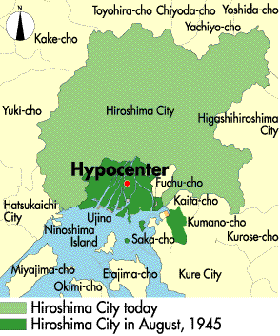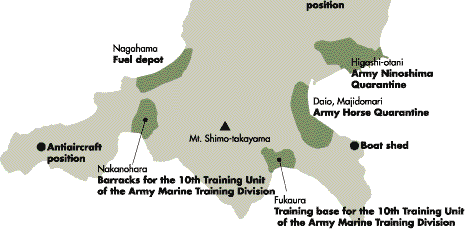 |
 |
| Introduction | ||
|
Ninoshima is a small island, just off the coast of Hiroshima City. At the start of the Sino-Japanese War, an army quarantine station was built on Ninoshima to serve as the first stop for soldiers returning from the front.
Immediately after the atomic bombing, this quarantine station became an emergency field hospital. In 20 days it received about 10,000 injured victims arriving from Hiroshima. Thousands upon thousands died on that island. Since the war, bodies have been found and exhumed on several occasions. No story of the atomic bombing would be complete without a chapter about Ninoshima. This special exhibition will describe the role of the quarantine station before the bombing, the situation in the emergency field hospital after the bombing, and the subsequent excavations of human remains.
|
| Military City Hiroshima and the Ninoshima Quarantine Station |
| The Sino-Japanese War began in 1894. Hiroshima's port, Ujina, was close to the western end of the Sanyo Railway. As a result, Hiroshima soon took the limelight as the primary military transportation hub for personnel and supplies going to China. Military facilities accumulated rapidly, and Hiroshima developed into a military city. At the end of the Sino-Japanese War, tens of thousands of soldiers returned from China to Japan. To isolate those soldiers and ensure that they had no infectious diseases, quarantine stations were hastily built on Ninoshima Island near Hiroshima, Hikoshima Island near Shimonoseki, and Sakurajima Island near Osaka. The Ninoshima Quarantine was a huge facility that could handle 5,000 soldiers per day. |
 |
1 Ujina Port sent soldiers and supplies to China Courtesy / Hiroshima Municipal Archives 1916, Ujina-machi |
| 2 Quarantine station built on Ninoshima Island (Second Disinfecting Station) Source / Map attached to the War Quarantine History of 1904 and 1905 Courtesy / Ground Self-Defense Force Medical School, Shoko-kan About 1905, Ninoshima Quarantine StationIn 1895, a temporary army quarantine station was built in Aza Nagatani, Ninoshima-cho to quarantine soldiers returning from the Sino-Japanese War. Ninoshima was selected because it is near Ujina Port, can dock large ships, has plenty of water with plenty of land available.The quarantine station was expanded at the time of the Russo-Japanese War, and a Second Disinfecting Station was built in Aza Higashi-otani, Ninoshima-cho. The facility was used as a quarantine station by the Imperial Army throughout the Pacific War and by the Ministry of Health and Welfare until 1958. |
 |
 |
3 Equipment for disinfecting clothing and belongings Courtesy / Kazunori Ishiodori Ninoshima Quarantine Station The importance of quarantining returning soldiers to make sure no virulent, non-native infectious diseases entered Japan was widely recognized. The soldiers’ clothes and all their belongings were disinfected with steam or a chemical agent. The quarantine station had the capacity to quarantine and the equipment to efficiently disinfect several thousand soldiers a day. |
 |
4 Soldiers boarding a barge to land on Ninoshima Courtesy / Hisakazu Kinekawa Offshore from the Ninoshima Quarantine Station |
 |
|
 |
|
|||||||||||||||||||||
| 5 Soldiers in the bath Courtesy / Kazunori Ishiodori Ninoshima Quarantine Station While their clothes and belongings were being disinfected, the soldiers received physical examinations and took a bath. Anyone suspected of having an infectious disease would be admitted to the quarantine hospital. |
Performance of the Army Quarntine Station on Ninoshima from the Sino-Japanese War until 1930 Exhibition / Brief History of the Ninoshima Quarantine After the Manchurian Incident in 1931, thousands of troops were sent from Ujina Port to the Chinese mainland, and injured, ill, or replaced troops returned to Ujina. All troops returning to Ujina stopped first for quarantine on Ninoshima, and army quarantine activities continued until the end of the war. |
|
||||
|
Ninoshima and the Atomic Bombing
Island of Final Rest Military City Hiroshima and the Ninoshima Quarantine Station Atomic Bombing Relief Activities Immediately after the Bombing Ninoshima Overflowing with Injured Anguished Voices Calling for Water; Family Members Searching for Loved Ones Sending off the Dead The Closing of the Emergency Field Hospital, then the Quarantine Station A-bomb Orphans Ninoshima of the Sleeping Dead Conclusion Return to TOP |


